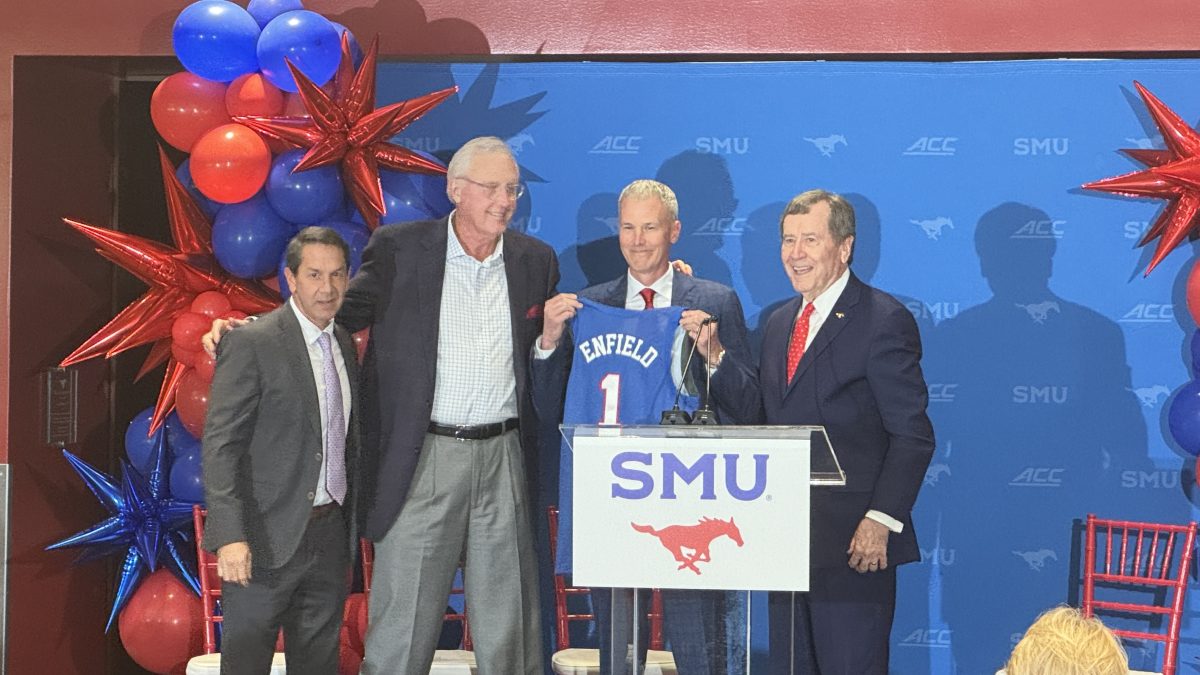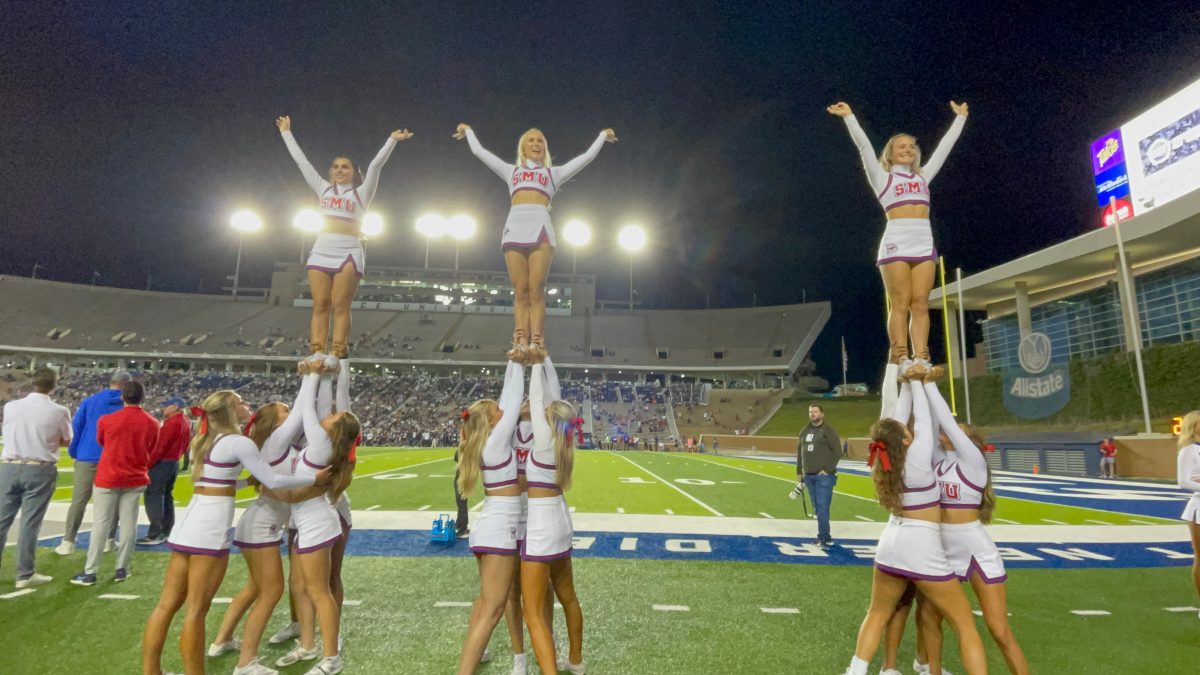Last year, around this time, theSports Desk gave you a list of the top 10 Professional athletes in the Dallas/Fort worth area. Our countdown was a large success with our readers that we decided to bring you another list. Only this time, we will stay on the Hilltop and count down the top 25 athletes to ever wear the red and blue at SMU.
While you may recognize some of the athletes on our list, it is our hope that by doing this countdown, you will have better knowledge of the rich athletic history of SMU. We will give two athletes per issue starting today and continuing until we reach our top five athletes. Once we narrow it down to the best of the best, we will give you the top five one at time until the semester is over.
Keep in mind, this list was compiled through numerous e-mails, complicated scientific formulas and talking monkeys. So, if at any point you think we placed someone too low or if you would like to nominate someone for consideration feel free to shoot us an e-mail.
Number 25: Luchi Gonzalez
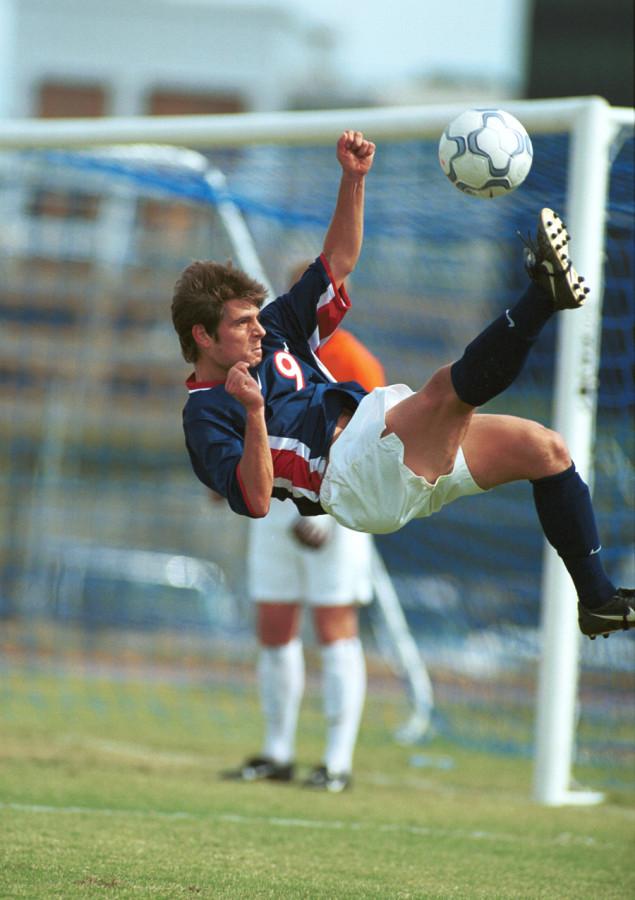
Coming in at number 25 is SMU soccer legend Luchi Gonzalez.
After playing four years as a Mustang, Gonzalez earned the Hermann Trophy as college soccer’s best player in 2001.
Gonzalez was drafted 6th overall by the San Jose Earthquakes in the 2002 MLS SuperDraft.
However, after an uneventful rookie season and failing to make the Columbus Crew’s roster, Gonzalez signed a contract to play with second division club Bodens BK.
Gonzalez performed much better abroad and scored eight goals and four assist during his first season in Europe.
In 2003, Gonzales returned to the U.S. to play with the Peruvian Sporting Cristal. He then found his way back to the MLS in 2005 and signed with the Colorado Rapids.
In 2007, he was waived by Colorado and signed with Miami FC. After one year in Miami, Gonzalez became the Boys soccer coach at Felix Varela Senior High School, where he led his squad to a state championship in 2008.
Gonzalez officially retired from professional soccer in 2009.
Number 24: Juan Castillo
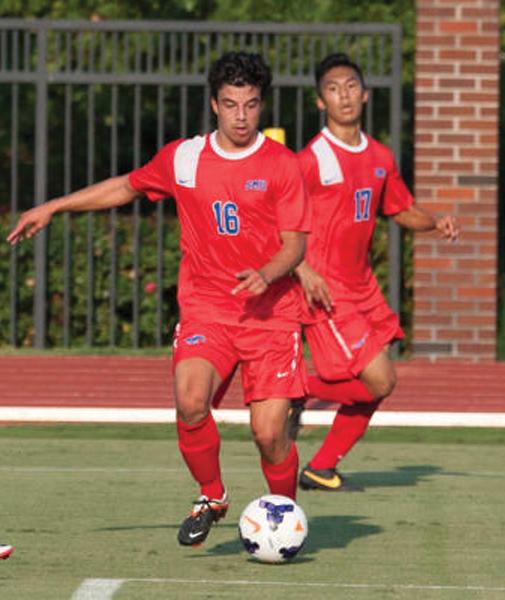
In 2013, Juan Castillo started all five matches he played for the Mustangs during his senior season (he was sidelined most of the season with an injury).
Castillo registered 13 shots (three on goal) and was named to the Jason’s Deli SMU Invitational All-Tournament Team.
It was a disappointing senior year for Castillo, but he did enough in his previous three years to earn the 24th spot on our list.
From 2010-2012 he played in 49 games and started 41. He also scored all 17 of his goals during those three years.
During his freshman year in 2010, Castillo tied for the team league in goals with 10, four of those were game-winners.
Castillo was a beast at SMU; make no mistake about it. While at SMU, he picked up 25 individual awards including 2010 Conference USA Freshman of the Year, 2011 Second Team All-Conference USA and 2012 C-USA All-Tournament Team.
Before coming to the Hilltop, Castillo was named second-team All-American, played club for Texans SCDTH, was a member of the Olympic Development Program State and Regional pools, was a member of the 2nd place team in the 2007 Disney Soccer Showcase, high school state finalists in 2010, named first team All-District, All-Region and All-State and received Newcomer of the Year honors.
Number 23: Lamar Hunt
Despite not being a major athlete while attending SMU, Lamar Hunt graduated to become one of the school’s most important alumni in the world of sports.
The man from Dallas attended school between 1952-56, earning a B.S. degree in geology and played for SMU’s football team from 1953-55, although his role was limited to riding the bench.
Without Hunt, the American Football league, the Kansas City Chiefs, the Super Bowl and sports as we know and love them now wouldn’t have existed.
Hunt was one of the major forces in getting then-NFL commissioner, Pete Rozelle, to agree to merge the NFL and AFL together, forming the United State’s most dominant sporting league today.
Outside of football, Hunt was a great messenger of athletics in his time before his passing in December of 2006.
He was a member of the Texas Sports Hall of Fame, the National Soccer Hall of Fame, the International Tennis Hall of Fame and of course the honorary hall of fame at SMU.
Hunt’s contribution to sports rises above almost anyone else in American history. The fact that he is a graduate of Southern Methodist University is something that should not be left off any list, certainly not this one.
Number 22: Richard Saeger
Richard Saeger is a former American swimmer and Olympic gold medalist.
He won a gold medal by swimming for the winning U.S. team in the 4×200-meter freestyle relay event at the 1984 Summer Olympics in Los Angeles, California.
But most importantly he was a Mustang in the ‘80s before it was cool.
No. 21: Akil Simpson
Next year, The SMU women’s basketball team’s first order of business should be finding someone to replace the presence of Akil Simpson in the post.
When people talk about SMU women’s basketball, Keena Mays is often the first name thrown out and Simpson is often overlooked.
What people fail to realize is that for the past three seasons, Simpson has led the Mustangs in rebounds and consistently been among the league’s leaders.
Simpson brought physicality and toughness to the Mustangs that proved invaluable. By establishing a strong and often dominant presence in the low post, Simpson opened things up for her teammates and created scoring opportunities by simply being on the court.
Her contributions to the team were obvious, whenever she would go the sideline, SMU would struggle. However, as soon as she’d come back in to the game, magically, the Mustangs would once again become a powerful team.
After a solid first year for the Mustangs, Simpson returned to dominate her sophomore season- finishing with 332 total points (10.7 PPG) and 233 total rebounds (7.52 RPG). That season, the SMU coaching staff named Simpson the team’s most valuable player.
With each season Simpson’s game improved and her impact on the court expanded. By her senior season in 2014 she was a force to be reckoned with.
Averaging 13.2 points and 8.3 boards a game, Simpson finished with 423 total points and 264 rebounds. With no player returning to the Mustangs next season coming within a hundred rebounds or points of Simpson, saying the she will be missed is a gross understatement.
No. 20: Zach Line
By Samuel Snow
Anyone who has attended SMU in the past five or six years knows who Zach Line is.
As a RB/FB, Line burst onto the scene in his sophomore year, but not before piling up seven touchdowns in his first-year season as SMU’s short-yardage back.
As a sophomore, Line had a season for the ages. He ran for 1,494 yards while averaging 6.1 yards per carry and compiling 10 touchdowns. The 1,494 yards was second all-time in SMU history, trailing only Eric Dickerson.
He was able to match the production from his sophomore season during his junior and senior seasons. In his junior season he amassed 1,224 yards and put up 17 touchdowns. To wrap up his college career, Line ran for 1,278 yards to go with 13 touchdowns in his senior year.
When all was said and done, Line had pulled together 3,967 yards. He also put up 40 touchdowns, good for third all-time, and he averaged 107.2 yards per game, the best in SMU history. To add to his rushing total, Line showed he was capable of receiving out of the backfield with 599 yards.
Nowadays, Line is the second string fullback for the Minnesota Vikings, but he’s second string to Jerome Felton, an all-pro fullback. The Vikings have kept Line around for two seasons. Maybe it’s because they see some talent in this dynamic fullback.
Number 19: Keena Mays
By Samuel Snow
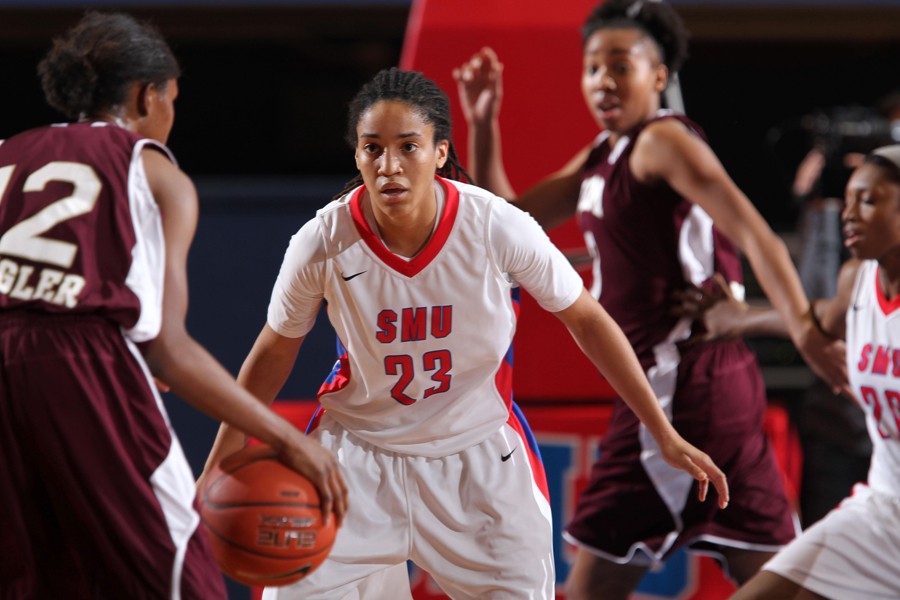
In her final year, she averaged 21.6 points per game and 5.3 rebounds per game. She also piled up 111 assists and had 74 assists. Not to mention she shot nearly .400 from three point range.
Her senior season was one of the best seasons by any SMU Mustang, and that’s why she ends up on this list.
When stretched out over the entire season, Mays’ 21.6 points per game came out to 691 points, good for best in SMU history passing her Head Coach Rhonda Rompola.
Mays transferred to Southern Methodist University from the University of Kansas to play her final two seasons at the Hilltop.
Her impact was immediate.
Before her spectacular senior season, she made a huge impact as a junior.
She averaged 18.4 points per game with 5.7 rebounds and 88 assists.
While SMU basketball featured a resurrection of sorts this season, Mays played a large role at SMU as a junior as well.
Mays played a massive role in SMU making it to the National Invitational Tournament as well as finishing over .500.
In her junior year, she was named the Conference USA player of the year, first-team All-C-USA and C-USA Newcomer of the year.
In her senior year — and first year of the American Athletic Conference — she was named an All-American for the conference.
While SMU didn’t get to the NCAA Tournament, the fans of SMU basketball got to witness one of greatest players to have passed through the women’s basketball program.
Mays answered the call to be SMU’s leading scorer with Akil Simpson as her solid sidekick.
Without Mays, SMU would have struggled to stay above .500 for the past two seasons.
She may be leaving, but Mays had one of the greatest careers — even if it was only two seasons — in SMU history.
Number 18: Quinton Ross
By Omar Majzoub
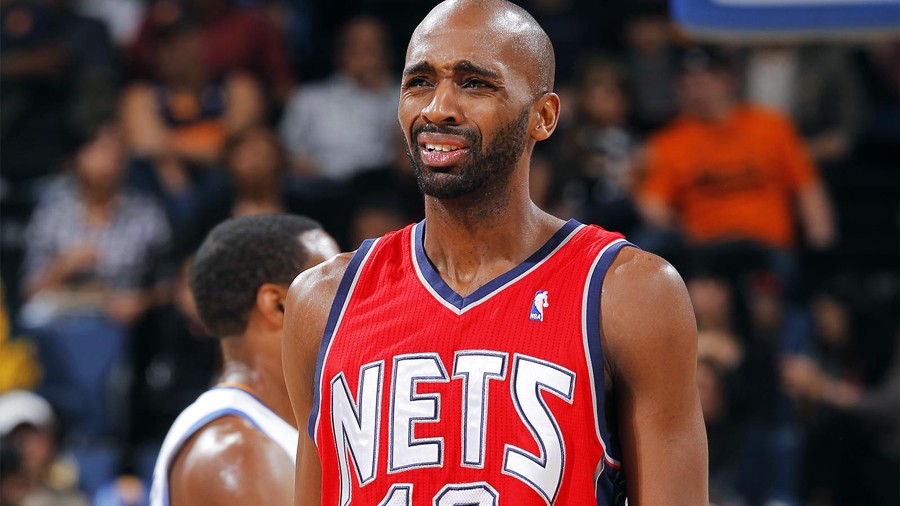
Ross, a native of Dallas, played four years at the Hilltop (1999-2003) and finished as the programs fourth all-time leading scorer with 1,763 career points.
In 119 total games as a Mustang, Ross averaged 14.8 points, 5.5 rebounds and 1.9 assists per game.
He was also the 2002-03 Western Athletic Conference Player of the Year and an honorable mention for the 2003 All-American team.
Ross, listed at 6-foot-6 and 195 pounds, went undrafted in the 2003 NBA Draft and played overseas in Belgium for one season before joining the Los Angeles Clippers in 2004.
He made his NBA debut Nov. 5 of that season and played four years with the Clippers before getting traded. Ross eventually played for four more NBA teams (the Grizzlies, Mavericks, Wizards, and Nets) from 2004 to 2011.
For his career, Ross is averaging 4.1 points, 2.1 rebounds, one assist and 20.4 minutes per game on 42 percent shooting. He has played in 370 NBA games, including 58 starts, and hopes to return to the league soon. At age 32, Ross played professionally in France last season with the Boulazac Basket Dordogne and spent a couple months in the NBA
Developmental League.
Ross is one of the most influential basketball players ever from the DFW area. He took Kimball High School, the same high school current SMU player Keith Frazier graduated from, to the state finals and played under Head Coach Royce Johnson for four years there.
Ross is one of the few players to ever play basketball in Dallas at the high school, college and professional level. He remains in the Dallas area today during the offseason and was recently seen supporting his alma matter at the SMU vs. California game during the NIT Tournament at Moody Coliseum.
Number 17: Margus Hunt
By Omar Majzoub

Margus Hunt is one of the most athletic players ever to come out of SMU. At 6-foot-8-inch and 280 pounds, the Estonian monster originally came to the Hilltop as an elite track-and-field athlete who wanted to work with world-renowned Coach Dave Wollman. However, Hunt changed sports when he officially became a Mustang and ended up making a huge impact on the football program.
With 4.6 40-yard dash speed and incredible strength, Hunt walked on as a first-year and made an immediate impact on special teams in 2007 by blocking seven kicks which was just one short of the NCAA record. He started all 13 games as a sophomore, registering 6.5 tackles for loss, three sacks and three blocked kicks.
As a junior, it was his three-sack effort in the BBVA Compass Bowl win over Pittsburgh that really put him on the map. Hunt was named All-C-USA honorable mention both those years while also being listed as the No. 1 athletic “freak” in college football by CBS because of his combination of size, length and speed.
As a senior starter in 2012, Hunt accumulated 31 tackles, 11.5 tackles for loss, eight sacks and one interception on his way to earning first team All-Conference USA honors. He ended his career with 17 total blocked kicks and the most blocked field goals in NCAA history. After SMU, Hunt was drafted in the second round of the 2013 NFL Draft by the Cincinnati Bengals.
Hunt is originally from Karksi-Nuia, Estonia, and has many athletic achievements outside of football. He was the world junior record holder in discus throw for many years and won the 2005 European Junior discus title. He was also the first junior athlete ever to win gold medals in both the shot put and Discus throw competitions when he won them at the 2006 World Junior Championships in Beijing.
Number 16: Rhonda Rompola
By Samuel Snow
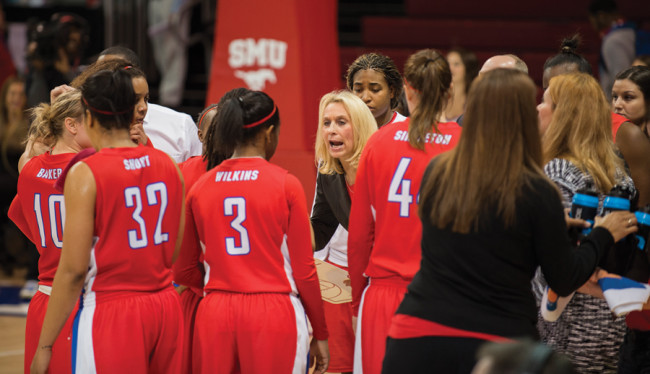
Casual SMU basketball fans probably don’t know who holds the position of head coach for the women’s basketball team. They also probably don’t know that she has been a Mustang for 30 years.
Rhonda Rompola joined the team as a junior transfer from Old Dominion in 1981. From thereon out she has been part of the team whether it was as a player, an assistant coach or as the head coach.
Rompola bleeds red and blue.
In her first year after transferring, Rompola led SMU in scoring with 21.2 points per game that came to 683 points (a record that was just broken by Keena Mays) and rebounds with 8.8 per game.
SMU has changed conferences multiple times since 1991, Rompola’s first year as head coach.
They’ve gone from the Southwest Conference to the Western Athletic Conference to Conference USA to the American Athletic Conference. Among the many changes, Rompola has been the steady rock.
In her 20 plus years as the SMU head coach some of her accomplishments have included becoming the WAC regular season champions as well as the tournament champions in 1998 and 1999, being names the WAC Coach of the Year in 1999, and winning the tournament for C-USA in 2008.
Not to mention she drew Mays from Kansas for her junior and senior seasons and helped her break the scoring record once held by Rompola.
Rompola has compiled over 400 wins for the Mustangs, more than any other coach in SMU history.
It’s hard to find someone with the accomplishments of Rompola who has stayed with the same program as the head coach for more than 20 years, but SMU has just that.
Rompola takes plenty of pride in her job, and that more than anything else has earned her a spot on this list.
Number 15: Emmanuel Sanders
By Samuel Snow

Many of the people on this list had a stellar college career or a great pro career. Emmanuel Sanders is not one of those.
Sanders followed up a career at SMU in which he led the team in receiving with 3,791, by continuing his solid play with the Pittsburgh Steelers.
Sanders caught 34 touchdowns during his SMU career while piling up at least 605 yards in each of his four seasons.
He was the model of consistency during his college career.
He endured back-to-back 1-11 seasons during his sophomore and junior years but was rewarded by pulling his team to the Sheraton Hawaii Bowl his senior season.
In his final two seasons for the Mustangs, Sanders was awarded All-Conference honors.
As a result of his illustrious career at SMU, the Steelers drafted Sanders in the third round of the NFL Draft.
Despite not putting up gaudy numbers in his rookie season, Sanders still found a way to put up 379 yards on 28 receptions.
In 2012, Sanders broke out and grabbed 44 passes for 626 yards.
Last year — his contract year — he put up career highs of six touchdowns, 67 catches, and 740 yards. Consequently, the Denver Broncos rewarded him with a three-year contract.
Sanders continues to have a solid NFL career, just like his college career. That feat has earned him number 15 on this list.
Number 14: Lars Frölander
When making a list of SMU’s greatest athletes, it make sense to mention one of the Hilltop’s greatest swimmers of all time: Lars Frölander.
As a Mustangs, Frölander ruled the waters from 1995-98.
He was the 1998 NCAA Swimmer of the Year and won the NCAA Championship in two events — the 100 meter freestyle and 100 meter butterfly.
It was a repeat performance for Frölander who won both of those events in 1997, and it was a three-peat for the 100 meter butterfly as he won that event as a first-year in 1995.
Once he left the SMU, Frölander continued to swim exceptionally well.
He has since competed in six consecutive Olympic Games (1992, 1996, 2000, 2004, 2008, 2012), for his native Sweden.
In the 2000 Olympics in Sydney, Frölander took the gold medal in 100 meter Butterfly. Shortly before the Olympic Games he broke the world record in same event twice.
After his performance in Sydney, he was awarded the Svenska Dagbladet Gold Medal.
He also took home silver medals in the in the 4×200 free relay in the 1992 Barcelona games and in the 1996 Atlanta games.
Number 13: Raymond Berry
By Samuel Snow
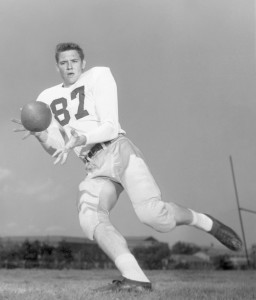
(Courtesy of SMU Athletics)
With this spot on the list, SMU fans will have to go back four or five decades, but there is no doubt this man earned a spot on SMU’s top 25 athletes list.
Raymond Berry made a name for himself in the NFL.
As a three-year athlete at SMU, Berry only caught 33 passes. However, this was mostly due to the college game being centered on running.
As Berry put it, “I didn’t catch many passes because not many were thrown.”
Despite this, the Baltimore Colts selected Berry in the 20th round of the 1954 NFL draft. Berry would spend his entire career with the Colts.
By his second year in the league, Berry was a starter for Baltimore.
Berry made himself one of the greatest wide receivers in NFL history, teaming up with quarterback Johnny Unitas to put up prolific numbers for his time.
His career was highlighted by his production in the 1959 and 1960 seasons.
During these two seasons, Berry caught 140 passes for 2,257 yards while corralling 24 touchdowns.
He made the Pro Bowl six times, was named to the AP First-Team All-Pro three times and named to the AP Second-Team All-Pro twice.
He also retired holding the league record (since broken) for receptions with 631.
At the end of his illustrious 12-year career, he was named to the Pro Football Hall of Fame in 1973.
Berry, following his career, immediately joined up with the Dallas Cowboys as the wide receivers coach.
Berry would coach all the way up until 1992 where he would finish up as the Denver Broncos quarterback coach.
However, his coaching career was highlighted by the time he spent with the New England Patriots.
From 1978 until 1981 he was the Patriot’s wide receivers coach. In 1981, following a poor season, the entire coaching staff was fired.
In 1984, though, New England Head Coach Ron Meyer was fired midseason.
The Patriots then hired Berry to take his place.
Berry had a successful head-coaching career up until 1989.
1989 was the year when new Patriots owner Victor Kiam demanded that Berry give up control and reorganize his staff. When Berry denied, he was fired.
Berry finished his head-coaching career with a 48-39 record.
The Baltimore Colts retired his number, 82. Also, he was named to the NFL’s 50th and 75th anniversary team.
For someone who made such a large impact in the NFL — at wide receiver before it was a big-time position — Berry has certainly earned a spot on this list.
Number 12: Russell Carter
By Billy Embody
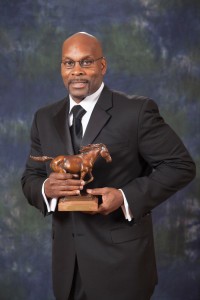
One of the greatest athletes to come through SMU was Russell Carter and a big reason why is because of the success he had in two sports: track and football.
Carter was inducted into the SMU Hall of Fame in 2013 because of his performance for SMU from 1980-83.
His best season was undoubtedly the 1983 track and field season where he was an All-American on the SMU NCAA Indoor and Outdoor National Championship teams and an All-American in the same year on the football team.
Carter was an All-American on the indoor mile relay team and the outdoor 1600 meter relay team, but also as a cornerback on the football team, all in 1983.
Carter was on the 1981 and 1982 NCAA-recognized National Champion teams all while being a three-time All-Southwest Conference honoree.
In one of the greatest moments in SMU football history, Carter made the biggest play, blocking a field-goal against Arkansas in 1982 that ended up keeping the game to a 17-17 tie.
Because of the tie, SMU finished the season 10-0-1 and earned a berth in the Cotton Bowl and a SWC conference title for the second straight season.
If it wasn’t for Carter’s blocked field goal in the second quarter, SMU’s 1982 season may have been viewed quite differently. Carter’s block came at a time when SMU had just turned the ball over and Arkansas was driving in SMU territory, but was held at the 10-yard line.
If Arkansas would have won, it would have been the Razorbacks that went on to the Cotton Bowl.
SMU went on to beat Dan Marino’s Pitt Panthers 7-3 and finished that season second in the AP poll behind a 12-1 Penn State team.
To cap off his SMU career, Carter was drafted 10th overall by the New York Jets in the 1984 NFL Draft.
Carter spent six seasons in the NFL with the Jets and the Los Angeles Raiders, appearing in 64 games with 47 starts.
Number 11: Ryan Berube
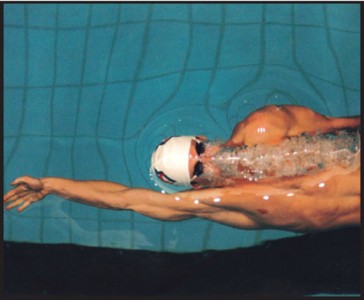
Ryan Thomas Berube adds to the already crowded group of swimmers even more prestigious to the SMU waters.
Not only is Berube another swimmer on our list, but he is also another Olympic athlete.
Born Dec. 26, 1973, Berube grew up to be one of the best swimmers in the world; winning the gold medal as the anchor on the U.S. men’s team in the 4×200-m freestyle relay at the 1996 Summer Olympics in Atlanta.
During his career at SMU, Berube dominated the poll and won a total of three NCAA Titles in 1996: the 100-m backstroke, 200-m backstroke and the 200-m individual medley.
His dominance in the water during the 1996 season earned the honor of NCAA Swimmer of the Year.
Today, Berube has a career at Credit Suisse in Family Wealth Management.
But despite settling down, Berube couldn’t stay out of the water for very long.
In 2010, he joined Swim across America in San Francisco and continues to swim with the organization.
Berube swims for those whose life has been affected by cancer and to honor his wife, Michele , who survived a brain tumor diagnosis at age 17.
For all his accomplishments in the water and for his efforts to raise cancer awarness, the sports desk awards the great Berube the 11th place on our list.
Number 10: Payne Stewart
By Billy Embody
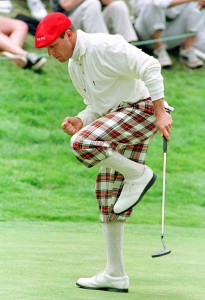
The late U.S. Open champion and SMU graduate Payne Stewart makes the list as the only SMU golfer to win three major championships including the 1989 PGA Championship and the 1991 and 1999 U.S. Opens.
Stewart was very popular on the PGA Tour with his distinctive style of ivy caps and patterned pants that were a throwback to the traditional golf “uniform.”
Just months after winning the 1999 U.S. Open, Stewart, along with his agents, Robert Fraley and Van Ardan, pilots Michael Kling and Stephanie Bellegarrigue and Bruce Borland, a highly regarded golf course architect, died in a plane crash Oct. 25, 1999.
The cabin of the Learjet traveling from Orlando, Fla. to Dallas lost pressure and the plane eventually crashed in Mina, South Dakota after two F-16 fighters followed the plane until it
went down.
Stewart was on his way to Dallas to discuss building a new home-course for the SMU golf program.
That week at the Tour Championship, golfer and good friend Stuart Appleby, organized a tribute to Stewart by donning one of Stewart’s own signature outfits and the rest of the field wore “short pants” as well.
Stewart’s 18-foot par put on the 72nd hole of the 1999 U.S. Open at Pinehurst was one of golf’s most dramatic finishes.
The moment is memorialized with a bronze statue of Stewart near the 18th green of Pinehurst No. 2.
During his SMU career, Stewart finished tied for 16th at the 1977 NCAA Championships and also won an individual Southwest Conference title in 1979.
Stewart was named to the 1979 second team All-American team and was an All-SWC selection during the 1978-79 season.
In February, the U.S. Golf Association announced Stewart as the recipient of the 2014 Bob Jones Award and will be honored during a public ceremony as part of U.S. Open festivities in June.
The 11-time winner is being awarded the USGA’s highest honor for having demonstrated the spirit, personal character and respect for the game exhibited by Jones, who won nine
USGA championships.
Stewart donated his time and financial assistance to charitable efforts that promoted the game and those in need.
Payne and Tracey, his wife, started the Payne Stewart Family Foundation to teach their children about giving back to the community.
Stewart is one of only eight players who have won at least two U.S. Opens and a PGA Championship. He was inducted into the World Golf Hall of Fame in 2001.
Number 9: Forest Gregg
By Billy Embody

Forrest Gregg, the man charged with reviving the SMU football program following the death penalty comes in at #8 in our Top 25 and for good reason.
Gregg won five NFL championships with the Green Bay Packers and one with the Dallas Cowboys as a player while starting 188 consecutive games from 1956 until 1971. The iron-man was an All-NFL selection eight straight years from 1960 through 1967 and was elected to the Pro Football Hall of Fame in 1977.
Gregg coached the Cincinnati Bengals to a Super Bowl in 1981, but lost to the San Francisco 49ers 26-21 in Super Bowl XVI.
After coaching the Bengals from 1980-83 and the Packers from 1984-87, Gregg was hired to revive SMU program. Gregg went 2-9 in his first season, which included a 95-21 beatdown by Houston, but the team’s first win is still one of the most historic wins for SMU.
Trailing 30-14 midway through the fourth quarter to Connecticut, SMU mounted a comeback that ended with Mike Romo’s touchdown pass to Michael Bowen with no time left to allow SMU to kick the extra point to win the game.
The game was immediately dubbed “The Miracle on Mockingbird.”
Gregg coached SMU for another season and then resigned to focus on his duties as athletic director for SMU. Gregg’s coaching record at SMU was 3-19, but he revived the program with a group of players that he has the utmost respect for.
“I never coached a group of kids that had more courage. They thought that they could play with anyone,” Gregg told The New York Times in 2012. “They were quality people. It was one of the most pleasurable experiences in my football life. Period.”
After serving as athletic director until 1994, Gregg returned to coaching in the CFL with the Shreveport Pirates, a brief attempt at expansion by the CFL in the United States. In 2005, Gregg was named Vice-President of Football Operations for the Ottawa Renegades.
Gregg now lives in Colorado Springs, Colo. In October 2011, Gregg was diagnosed with Parkinson’s Disease, thought to be caused from his long football career.
Number 8: Jon Koncak
There’s a lot to be said about Jon Koncak — or Jon “Contract” if you choose — but the large contract, one that was for superstar-type money in the late ‘80s, doesn’t deny one thing: Koncak had a stellar college career and a solid, 11-year professional career. That’s why he’s on this list.
Koncak attended SMU before the days of players who attended college for one year and left for the NBA. As a result, Koncak attended SMU for all four years, 1981-84.
He led the team in scoring for his final three years, something that, even by today’s standards, is impressive.
His production at SMU earned him a spot on the 1984 men’s basketball team for the Olympics.
That team, the final amateur team for the U.S. to play in the Olympics, won a gold medal.
Koncak played with the likes of Michael Jordan, Patrick Ewing, Vern Fleming, Chris Mullin, Sam Perkins, Alvin Robertson and Wayman Tisdale on that team.
This was before they became NBA players and before their superstardom.
The seven-foot center was the highlight of the 1983 and 1984 team that made the NCAA Tournament.
In both cases the SMU Mustangs won in the first round, but lost in the second round.
In his senior season, Koncak was voted as a consensus second team All-American.
During his senior season, the Mustangs spent the entirety of it in the Top-25, topping out at number two in the nation.
This was the last time, before this year’s Mustangs, that SMU was ranked in the top 25.
Koncak finished his four-year career as SMU’s leader in rebounds, 1,169 and blocks, 278, third in scoring, 1,784 and second in field-goal percentage, .559.
As a result of his stupendous career at SMU, Koncak was one of two players to have their number retired by the university.
Being one of the top college basketball players, Koncak was picked by the Atlanta Hawks as the number five pick in the 1985 NBA draft.
Koncak, while not living up to the lofty expectations set for him, had a solid NBA career as a bench player and defensive specialist.
Size has always been desired in the NBA, and Koncak provided just that. He even garnered one of the largest contracts at the time.
His best season in the NBA was probably his rookie season wherein he averaged a career-high 8.3-point per game.
His career-best in rebounding, 6.8-rebounds per game, came in the 1987-88 season while his career-best in blocks, 1.5, came in the 1993-94 season.
Koncak, being one of the best players in SMU history, was inducted into the SMU Hall of Fame in 2010.
Koncak may not have lived up to the expectations as the No. 5 pick in the draft, but having an 11-year NBA career is more than enough, especially when factoring in his college career.
Number 7: Lance Mcilhenny
By Samuel Snow
Lance McIlhenny may surprise some people being this high up on the list, but as the winningest quarterback in SMU history, he certainly deserves it.
Against the No. 2 ranked Texas Longhorns, Head Coach Ron Meyer made a surprising decision regarding his starting quarterback.
All-American Mike Ford was benched in favor of McIlhenny. That turned out to be one of the greatest decisions in SMU football history.
The SMU Mustangs went on to pull a massive upset of the Texas Longhorns, thus starting one of the greatest careers for an SMU quarterback.
McIlhenny went on to post a 34-5-1 from 1980 to 1983.
He was a three-time All-SWC honoree, and his 34 wins are still the most in SMU and SWC history.
He was recognized for his accomplishments on the football field as quarterback at SMU for the 1980-1983 seasons and was inducted into the SMU Athletics Hall of Fame in 2013.
Also in 2013, McIlhenny joined CBRE from Cresa Partners, where he was responsible for local and national business development. Before that, he was a senior managing director at CASE Commercial Real Estate.
He has also worked for Jones Lang LaSalle and The Staubach Company for 19 years.
For all that he did for SMU during the ‘80s, he has earned his spot inside the top 10 of our list.
Number 6: Steve Lundquist
By Billy Embody
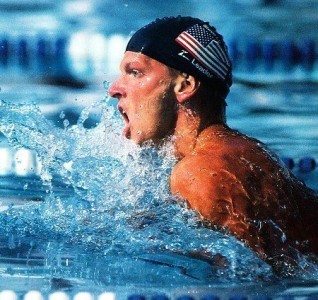
to 1989. (Courtesy of atlantasportshalloffame.com)
Steve Lundquist, an Olympic gold medalist, comes in at No. 6 in our Top 25 of SMU athletes.
The 100-meter breaststroke and the 400-meter medley relay gold medal winner in the 1984 Summer Olympics in Los Angeles attended SMU until 1984 when Lundquist graduated from the Cox School of Business.
Lundquist was the first swimmer to break two minutes in the 200-yard breaststroke as well and won every breaststroke event he entered from 1980-83.
At 17, he broke his first world record and broke multiple world and American records on 15 different occasions.
Lunquist held the 100-meter breaststroke world record from 1982 to 1989, except for one month.
Lundquist began his career as a butterfly swimmer and was coached by Arthur Winters to be the breaststroke swimmer that dominated competition for his career.
When People Magazine interviewed him at 23, he said he felt old for his sport, so he took up high speed thrills to feel young again like motorcycles and waterskiing.
It worked out for him as he eventually won the two gold medals in the Olympics.
Coincidentally, People Magazine also awarded Lundquist with the Best Chest of male celebrities, earning him a lot of exposure when the award was featured in the magazine.
At SMU, Lundquist was an All-American while he began his Olympic career and started his path to becoming the 1982 U.S. Swimmer of the Year and eventually a member of the International Swimming Hall of Fame in 1990.
Lundquist was selected as a U.S. Honorary Olympic Team medalist in 1980 as well.
Not only was Lundquist an accomplished swimmer, he was a philanthropist, volunteering his time for charitable organizations and making appearances on television and in movies.
In the 1996 Olympics in Atlanta, Lundquist was an Olympic Torch Bearer and was an Olympic Flag Bearer as well.
Lundquist returned to his native Georgia, where he runs Digipik, a digital media company.
Number 5: “Dandy Don”
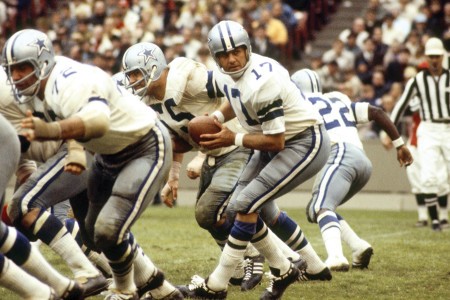
We now come to the top five athletes on our list, and kicking things off is none other than the late, great “Dandy Don” Meredith.
Born April 10, 1938 in Mount Vernon, Texas, Meredith would go on to become one of Dallas’ most heralded athletes.
In his youth, Meredith attended Mount Vernon High School where he was a dual-sport stud — playing both basketball and football.
It wasn’t all sports though; Meredith was as rounded a student as you could get. He performed in several plays and even graduated second in his class.
Upon graduation, Meredith elected to attend SMU, choosing the Mustangs despite being heavily recruited by the Texas A&M Aggies.
Once on the Hilltop, Meredith wasted no time in asserting himself and led the Southwest Conference in passing completion percentage in each of his three years as the Mustangs starting quarterback.
In addition, Meredith was an All-American selection in 1958 and 1959.
Meredith’s fame on the field led to his classmates jokingly referring to the school as “Southern Meredith University.”
In 1983, Meredith received the University’s Distinguished Alumni Award, and then in 2008, his number 17 jersey was retired at an SMU v. Houston game.
After a stellar collegiate career, Meredith sought to take his talents to the NFL.
Meredith would eventually quarterback for the Dallas Cowboys, but when he entered the NFL the Cowboys did not exist and therefore could not draft him in the 1960 NFL Draft.
However, in 1959, Meredith signed a contract with Tecon Corporation’s Clint Murchinson, agreeing to play for the Cowboys when they received an NFL franchise.
Meredith was drafted by the Chicago Bears in 1960 and traded to the Cowboys for a compensatory third-round pick for the 1962 Draft.
Because Meredith “joined” the organization before it even existed, he is considered the first Cowboy.
After spending two years as Eddie LeBaron’s back up, Cowboys Head Coach Tom Landry awarded Meredith the starting role in 1963.
Three years later, Meredith led Dallas to the NFL Championship where the Green Bay Packers defeated the Cowboys 34-27.
Meredith was also named the NFL player of the year in 1966.
The following year, Green Bay would hand Meredith another crushing defeat (21-17) in the famous “Ice Bowl” game in 1967.
Meredith never led the Cowboys to the Super Bowl, but “Dandy Don” will always have a special place in the hearts of Cowboys fans for his toughness, leadership and
sparkling personality.
Over his entire NFL career, Meredith posted a 50.7 percent completion rate, 17,199 yards, 135 touchdowns and an all-time quarterback passer rating of 74.8. He was also elected to the Pro Bowl three times.
Meredith couldn’t stay away from football for too long though in 1970 he returned to the sport as a commentator
for ABC’s “Monday Night Football.”
The former Cowboy added a needed change of pace and brought a casual tone of voice to the broadcast.
He was best known for singing the line “Turn out the lights, the party’s over”, from Willie Nelson’s “The Party’s Over” during a blowout.
Never being just a one trick pony, Meredith also had somewhat of an acting career. He starred as Detective Bert Jameson on “Police Story,” and appeared in several Lipton
Tea commercials.
Meredith, who passed away in 2010 after suffering a brain hemorrhage, was a colorful personality, an effective leader and a gifted athlete.
For all his accomplishments on and off the field during his lifetime, he comes in at number five on our list.
Number 4: Jerry LeVias
By Omar Majzoub
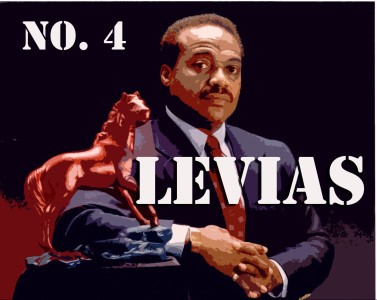
Jerry LeVias is one of the most influential athletes in SMU history for what he accomplished on and off the field as a Mustang. He started on the Hilltop in 1965 when he signed to play football under Head Coach Hayden Fry.
The addition of LeVias was a historical moment for college football and the sporting world because he was the first African-American scholarship athlete and second African-American football player in the Southwest Conference.
By adding him to the team, SMU helped integrate the sport of college football and forever changed sports history.
As a player, LeVias was honored and recognized with numerous awards in his college career.
He was named All-SWC three times and became an All-American during his senior year.
He twice led the league in receiving yards and held just about every career record for a wide receiver when he left SMU in 1968.
In total, he caught 155 passes and scored 25 touchdowns during his time as a Mustang.
While at SMU, LeVias also made numerous athletic and academic All-America teams and still holds the single game record for receptions in a game.
He caught 15 passes against Ohio State in 1968 and finished with 1,131 yards receiving yards that year, which landed him fifth in Heisman balloting.
LeVias also won the Fort Worth Kiwanis Club Award for Sportsmanship and was Most Valuable Back and Player in the Senior Bowl in 1969.
SMU football was on fire during the 1960’s and LeVias was a big reason for that. He led the Mustangs to their first SWC conference-championship in 18 years in 1966 and a Bluebonnet Bowl victory over Oklahoma in 1968.
He also played a big role in getting the Mustangs to their first Cotton Bowl appearance in almost 20 years. By his senior year, LeVias was known for being one of the most exciting players in the entire country because of his speed and hands.
He learned how to block on running plays and was fearless going over the middle despite his size.
Although his accomplishments on the field are impressive, LeVias should also be recognized for his impact off. He was born Sept. 5, 1946 just outside of Houston at a time where racial tensions were very high. LeVias dealt with a lot of criticism and harsh treatment while growing up and playing at SMU.
Fans, opposing players and even some teammates and classmates were cold, distant and hostile towards LeVias throughout his career. He became very religious to help him deal with the pain and suffering.
This faith led him to wear jersey No. 23 for Psalm 23. To honor his impact, LeVias was inducted into the Texas Sports Hall of Fame in 1995 and to the National College Football Hall of Fame in 2003.
Coaches and teammates say LeVias had the character, academic potential and skill that were needed to successfully integrate the sport and change it forever. LeVias football career started at Herbert High School in Beaumont, Texas.
He had terrific speed, but played quarterback because of his small frame. LeVias was listed at about 5-foot-9 and 177 pounds when he began receiving college offers.
He said he chose SMU after not being recruited by traditional historically black schools that he wanted to attend.
In 1969, LeVias entered the AFL Draft and was taken in with the 40th pick in Round 2 by the Houston Oilers.
He played two years in Houston, where he was selected to the 1969 AFL All-Star Team and named Rookie of the Year. After that, he moved on to the San Diego Chargers of the NFL and played for three more years (1971-74). When his career ended, LeVias became a successful businessman in Houston and credits his academic studies at SMU for his success. He is now 67 years old.
Number 3: Doak Walker
By Billy Embody
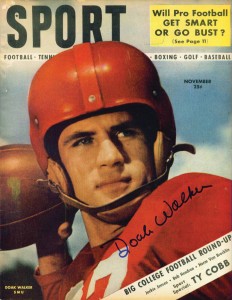
Honored on SMU’s campus with a statue and plaza in his name, Doak Walker is known throughout the football world as one of the best players ever to play the game.
The award for the nation’s top running back in collegiate football is named every year the Doak Walker Award and for good reason.
Walker almost did not attend SMU, but after a trip to see SMU play in New Orleans and his high school coach, he chose to enroll at SMU over going to Texas.
Walker enrolled on a Monday and played for SMU against Texas the next Saturday, and the rest is history.
Walker’s college career was briefly interrupted after he was drafted in the U.S. Army in 1946, but was able to get back to SMU in 1947 and that’s when “Poetry in motion,” started as Dan Jenkins, editor of a biography on Walker, put it.
Walker was an All-American at SMU in 1947, 1948 and 1949 as a two-way back.
Walker punted, returned punts and kickoffs and even kicked extra points for the Mustangs, winning the Maxwell Award as a sophomore and the Heisman Trophy as a junior.
To this day, Walker is still the only Mustang to win the Heisman Trophy, even though he was just 5-11, 170 pounds.
During his career, Walker and the Mustangs played in the Cotton Bowl on multiple occasions and it quickly became known as “The House that Doak Built,” and SMU had to move their home games to the Cotton Bowl just to allow more fans to see Walker play.
Walker used to say though after games that he’d be sore, but, “…I never got any blisters working on that stadium.” thirty-thousand seats were added to the Cotton Bowl during Walker’s time on SMU’s team as the team quickly outgrew Ownby Stadium on campus.
While Walker was injured most of his senior year, Collier’s Magazine was still ready to name him to the All-American team, but Walker instead asked for them to give it to a player that was more deserving. Collier’s instead named Walker the 1949 Player of the Year for Sportsmanship.
AP did name Walker to their All-American team in 1947, 1948 and 1949 though.
His incredible college career included 3,862 yards of total offense and 303 points.
After his time at SMU was finished, Walker landed with the Detroit Lions of the NFL and was named Rookie of the Year in 1950 and was an All-Pro selection for four of his six seasons that he played.
Once he was reunited with his old Highland Park High School teammate Bobby Layne, the duo led the Lions to championships in 1952 and 1953.
Walker retired in 1955, accepting a job with a electrical construction company for the salary that he was earning in the NFL. Walker moved to Colorado when the business moved there, and remained in Colorado for the rest of his life.
Walker gave it a thought to coach football, but didn’t like the direction college football was headed.
Walker was inducted into the College Football Hall of Fame in 1959 and the Texas Sports Hall of Fame in 1973, but the NFL kept him out until 1986.
Once Walker was inducted into the NFL Hall of Fame, he said, “Now, I can finally retire.”
Walker wasn’t just a football player at SMU, he lettered on the basketball and baseball teams and was a member of Phi Delta Theta.
At Highland Park, Walker lettered in five sports, basketball, swimming, track, baseball and football. His teammate, Layne, ended up fueling the SMU-UT rivalry while the two were
in college.
Walker was seriously injured in a skiing accident in 1998 and his injuries kept him incapacitated until his death in Steamboat Springs, Colo. Sept. 27, 1998.
Number 2: Craig James
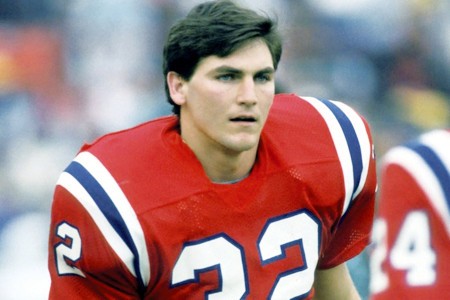
When former SMU running back Craig James arrived on campus in 1979, almost everyone knew he’d be playing second fiddle to the great Eric Dickerson.
Despite that, James gave the Mustang faithful some of the best years on the football field the school has ever known in the early ‘80s.
Coming out of high school, James was regarded as one of the nation’s top runners, but decided to forego an offer from the University of Alabama and legendary Coach Paul “Bear” Bryant to stay in his home state, and play at the Hilltop, something all Mustang fans could thank James’ future wife Marilyn for.
It was clear “The Pony Express” would be a force to be reckoned with inside the Southwest Conference once the ’79 season began thanks to both Dickerson and James.
The first-year from Houston tallied just under 1,000 all-purpose yards and four touchdowns, according to pro football reference, enough to earn James the conference’s newcomer of the year award.
While the team finished that first season with James at 5-6 overall, the pieces were in place for the Mustangs to make some noise for the first time since Doak Walker rampaged through the record books.
For each of the next three seasons while “The Pony Express” was running wild, James tallied over 1,000 yards running and receiving, and even helped on special teams by punting both his junior and senior seasons.
James was even part of the team many publications named the national champions of 1982 that defeated Dan Marino and the Pittsburgh Panthers in the Cotton Bowl, 7-3.
The NFL eventually saw what James had to offer when he was signed by former SMU head coach Ron Meyer and the New England Patriots.
For five seasons, James showed the same type of work ethic and ability that was on display for the Mustangs, including a pro bowl season in 1985. James rushed for 1,227 yards and caught 27 passes for another 360 yards in helping his Patriots reach the Super Bowl.
Even though the Pats would be defeated by arguably the best defense of all time in the 1985 Chicago Bears, James still showed just how versatile he could be and made a great name for himself in the National Football League.
After his playing days were over, James was hired on by ESPN to broadcast college football games, and was given a vote in the Associated Press’ poll for college football rankings. He also had a short run at Fox Sports Southwest and made a modest attempt to enter politics in 2012.
Despite the shortcomings, James’ time at SMU was a ride for the ages, and should be remembered fondly as some of the best times just before the worst times at the Hilltop.
He is one of the greatest running backs in Mustang history, and that alone is something to admire, given the dominance of some names in the record books.
Number One: Eric Dickerson
By Billy Embody
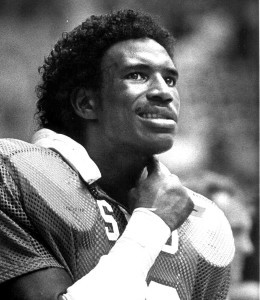
Eric Dickerson. Single-season NFL rushing champion for 30 years now after setting the record in 1984, was also a part of SMU’s famed Pony Express backfield.
Dickerson, a Sealy, Texas native, was a first round pick by the Los Angeles Rams after a successful career at SMU, which included being named an All-American.
From 1979-82, Dickerson rushed for over 4,400 yards and 47 touchdowns, breaking Earl Campbell’s Southwest Conference record for yards and attempts while tying Doak Walker’s career scoring total record at SMU.
Dickerson was a first-team All-American in 1982 and a second-team All-American in 1981. While splitting carries with Craig James, Dickerson still finished third in the Heisman Trophy voting behind Herschel Walker and John Elway.
Dickerson and James, longtime friends, almost didn’t combine to form the Pony Express with Dickerson wanting to transfer after his first season, but instead remained to give it a try.
Good call. The pair formed one of the most lethal duos running the football in the history of the NCAA.
Even with his successful college career, Dickerson is still believed by many to be at the center of one of the biggest controversies in recruiting history when he started driving a Pontiac Trans-Am during his senior year of high school, while recruiting promises and payments were rampant.
To this day, Dickerson maintains that his grandmother bought it for him.
“Even if I did take something, I still wouldn’t tell,” Dickerson has said on multiple occasions.
Controversies aside, Dickerson was a key reason for Head Coach June Jones being hired by then-director of athletics Steve Orsini that had restored SMU football to national relevancy.
Many of the players associated with the “Death Penalty,” era have been welcomed back and even though Dickerson has said he has never taken anything and that many of the problems stemmed from slush funds in the later years, he believes he gets some unfair blame for the scandal.
Dickerson also was an immediate success with the Rams after being drafted No. 2 overall, rushing for over 1,800 yards and 20 total touchdowns during his rookie campaign.
For his efforts, Dickerson was named All-Pro, Player of the Year, Rookie of the Year and to the Pro Bowl.
Dickerson wasn’t finished though.
That next season, Dickerson set a mark that is still unbroken, breaking O.J. Simpson’s single season rushing total with 2,105 yards.
Dickerson had two more successful seasons with the Rams, but a contract dispute ended up getting him traded in a 10-player trade that reunited him with former SMU Coach Ron Meyer in Indianapolis with the Colts.
With Dickerson’s 1,011 yards for the Colts, the team made a late season run to secure their first winning season and playoff berth in 10 years.
In 1989, Dickerson passed the 10,000 career yards mark and was the fastest player ever to do so, 91 games, beating marks set and eventually set by Jim Brown, Barry Sanders and Emmitt Smith.
Dickerson had a poor last four years in the league, rushing for under 1,000 yards while showing flashes of brilliance, but the consistency of 1,000 yards for his first seven seasons in the NFL were gone.
Dickerson passed Jim Brown and eventually Tony Dorsett to finish his career in second place on the all-time NFL rushing yards list.
Dickerson’s final career rushing statistics were 13,259 yards on 2,996 attempts for 90 touchdowns.
The Rams retired Dickerson’s number 29 and he was inducted into the Pro Football Hall of Fame in 1999, his first year of eligibility. The Colts also inducted him into their ring of honor in 2013.
One of the greatest running backs ever, a huge reason why SMU football has a great past and, in Adrian Peterson’s sights, almost every season. Eric Dickerson, the No. 1 player in SMU Athletics’ storied history.








